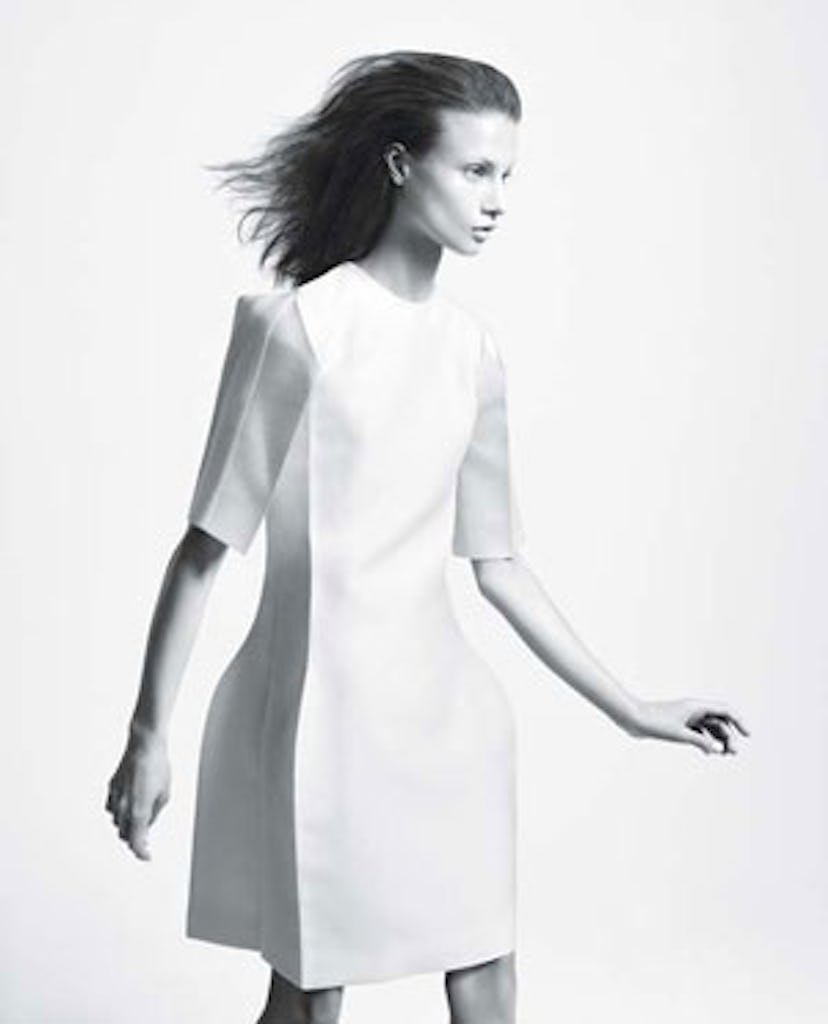Contradicting Coco Chanel’s maxim “Elegance is refusal,” the styles of the past few seasons have consistently preferred yes to no. Yes to sequins and spangles, yes to feathers and fur, yes to glitzy trimmings of every type—with the result that casual Fridays have come to look suspiciously like cocktail parties, and vice versa. But these flourishes, like glittery streaks of last night’s eye shadow, have ceased to feel fresh. In their place a spare, restrained aesthetic has emerged as fashion’s latest holy grail, spearheaded by Phoebe Philo’s stripped-down chic at Céline, Francisco Costa’s quiet understatement at Calvin Klein, and Raf Simons’s rigor at Jil Sander. Elyssa Dimant’s fascinating book Minimalism and Fashion: Reduction in the Postmodern Era (Collins Design, $75), out this month, looks at the big picture in order to examine how simplicity has staged a comeback.
The rejection of artifice, as Costa himself emphasizes in the book’s foreword, does not mean an eschewal of artfulness or art. Indeed, as Dimant persuasively demonstrates, today’s minimalist fashion owes a crucial debt to the avant-garde visual culture of the Twenties and the Sixties. During both of these periods, she writes, the “clean, streamlined shapes” so fundamental to modern art (Kasimir Malevich’s geometric paintings, Donald Judd’s steel boxes) and architecture (Le Corbusier’s celebration of “the cube, the sphere, the cylinder, and the pyramid”; the Pan Am Building’s mechanistic iron-grid facade) reappeared in fashion and forever changed its face. From Chanel’s unfussy little black dress to Courrèges’s and Cardin’s pared-down, futuristic shifts, the watershed styles of the Twenties and the Sixties folded contemporary artistic values—sleekness, simplicity, and progress—into “a vocabulary of easy dressing that would come to define modern fashionability,” Dimant concludes.
In the Seventies and Eighties, minimalist fashion parted company with the fine arts, turning its attention to functional basics such as T-shirts and jeans. Far less expensive than anything Chanel or Courrèges ever designed, these became democratic wardrobe staples, yet it was Calvin Klein who savvily recognized that certain consumers would pay a premium for the none-too-democratic cachet of a “designer” brand name. The plainest, most unprepossessing articles of clothing could be, and were, ennobled by the label alone.
The paradoxical interplay between formal understatement and symbolic ostentation reached its apogee in the Nineties, when, Dimant writes, Klein and Marc Jacobs “found in the simple slip dress the perfect reductive form in which to clothe their high-end clientele.” In keeping with Geoffrey Beene’s dictum that only the immensely wealthy can afford to be excessively simple, it was the slip dress’s very austerity that identified its wearer as a woman of privilege. This faux-ascetic ethos extended even to the settings in which minimalist apparel was marketed: the eerily desolate “nonplace” backdrops favored by fashion photographers at the time, and the sterile “white cube” architecture of big-name boutiques. Like the Duchess of Windsor’s infamous feminine ideal—“never too rich or too thin”—Nineties minimalism made an air of deprivation the ultimate status symbol.
Today’s minimalism may also enjoy such prestige, but its real significance lies in the return to its emphatically artistic roots. Not since the Sixties, Dimant says, has minimalist fashion engaged so intensely with other art forms’ experimental treatments of shape and space. As a result, its creations are “more like wearable sculpture” than ordinary clothing. Costa echoes this view, admiringly referencing Judd’s steel boxes while discussing his own attempt “to express the perfection of the square” in a recent collection based entirely on that elemental form. Underlying both Judd’s work and Costa’s (as well as that of other minimalist designers) is an obsessive, endlessly inventive exploration of proportion and line, surface and structure. It is by striking a delicate balance between complex artistry and purified plainness that the new minimalism manages to whisper “Less is more” and “Look at me” in the same seductive breath.
Calvin Klein: David Sims
